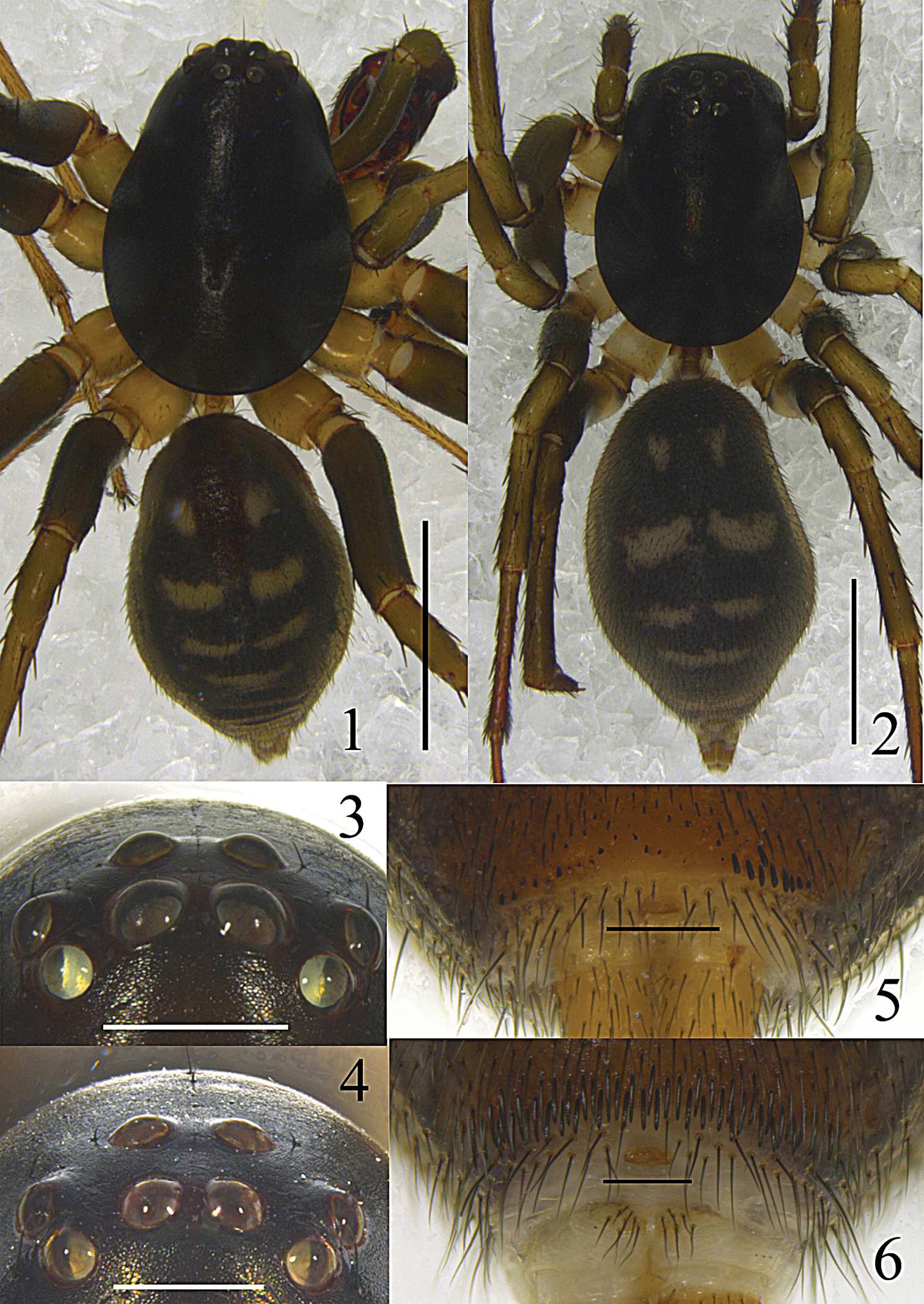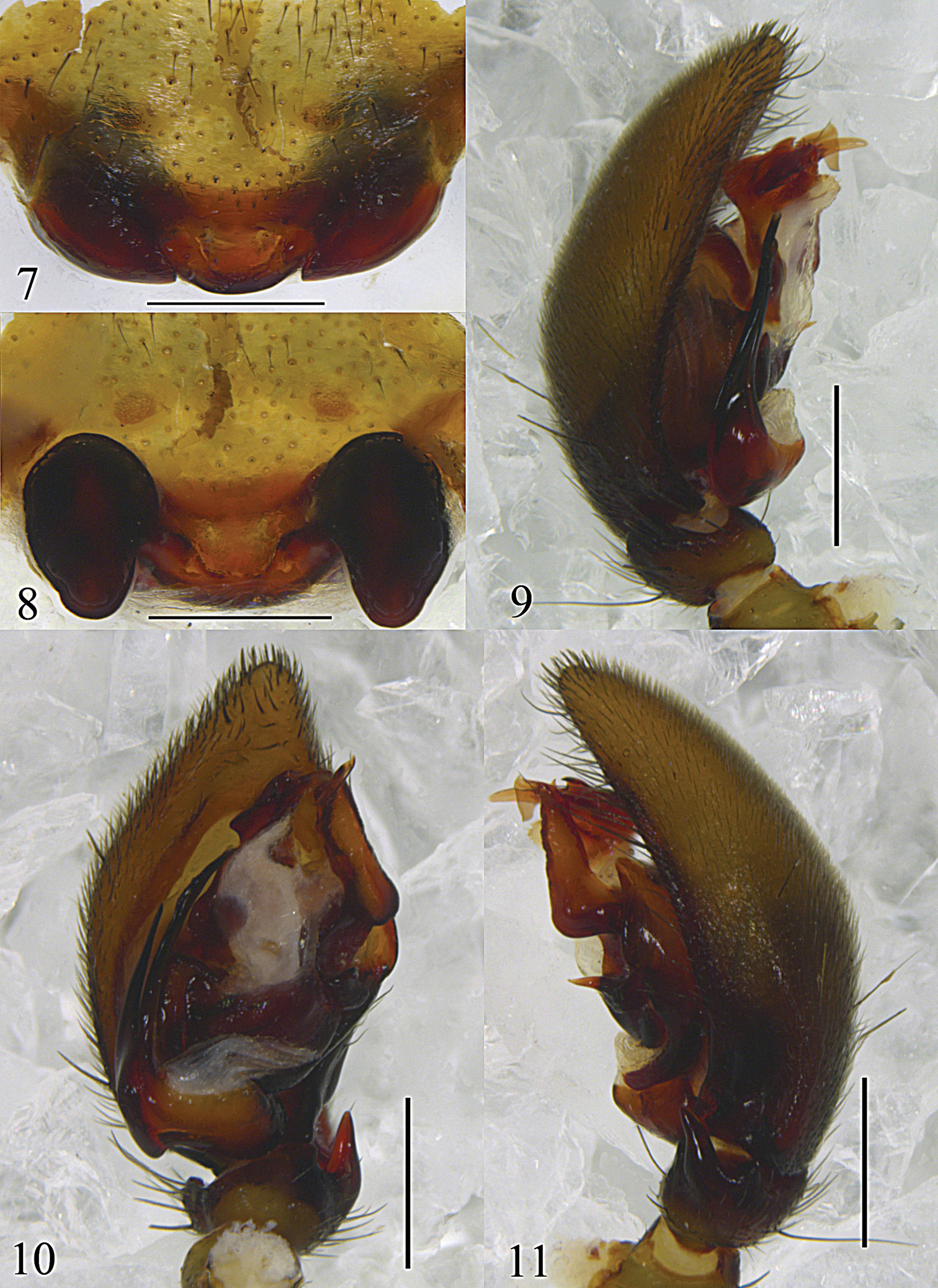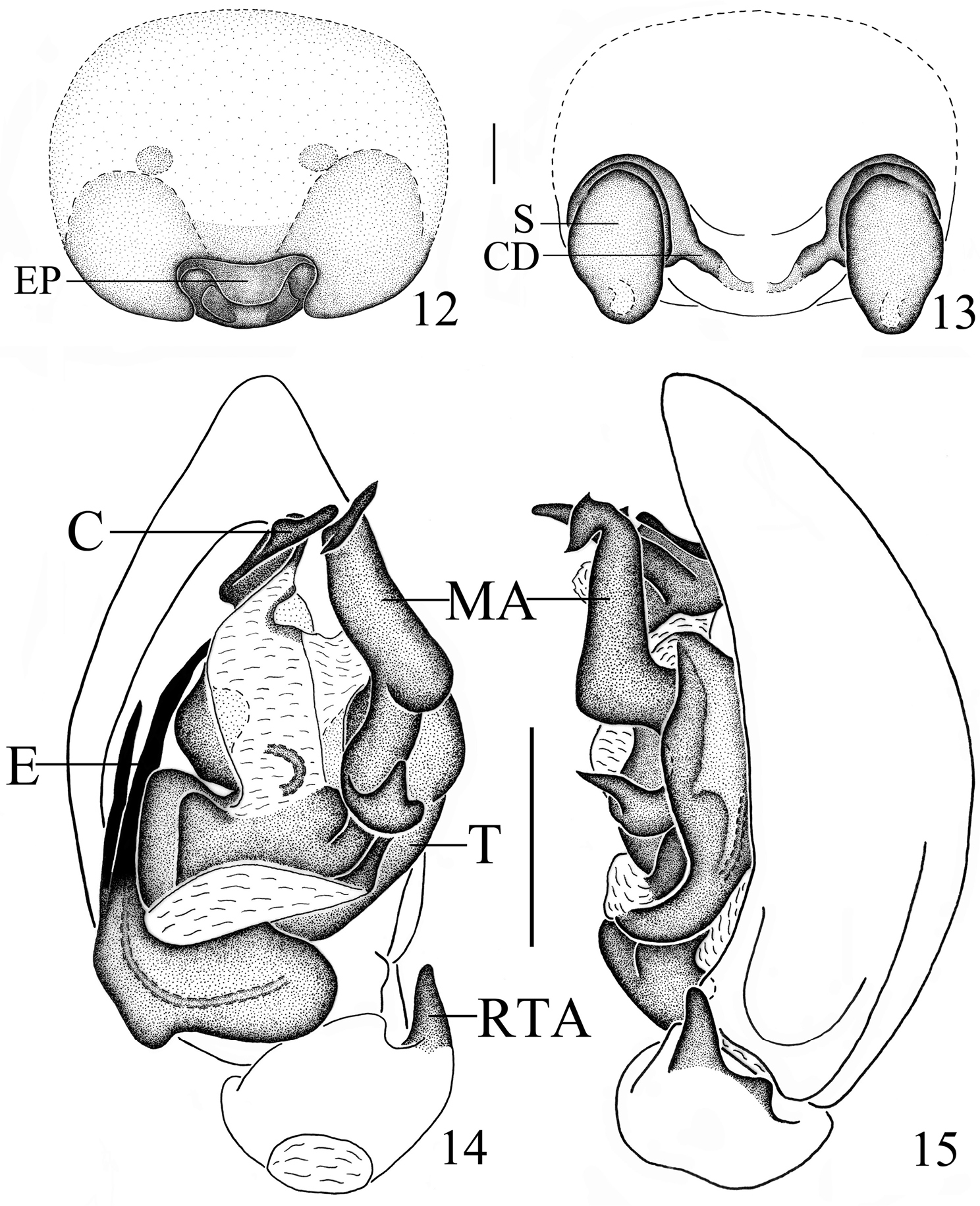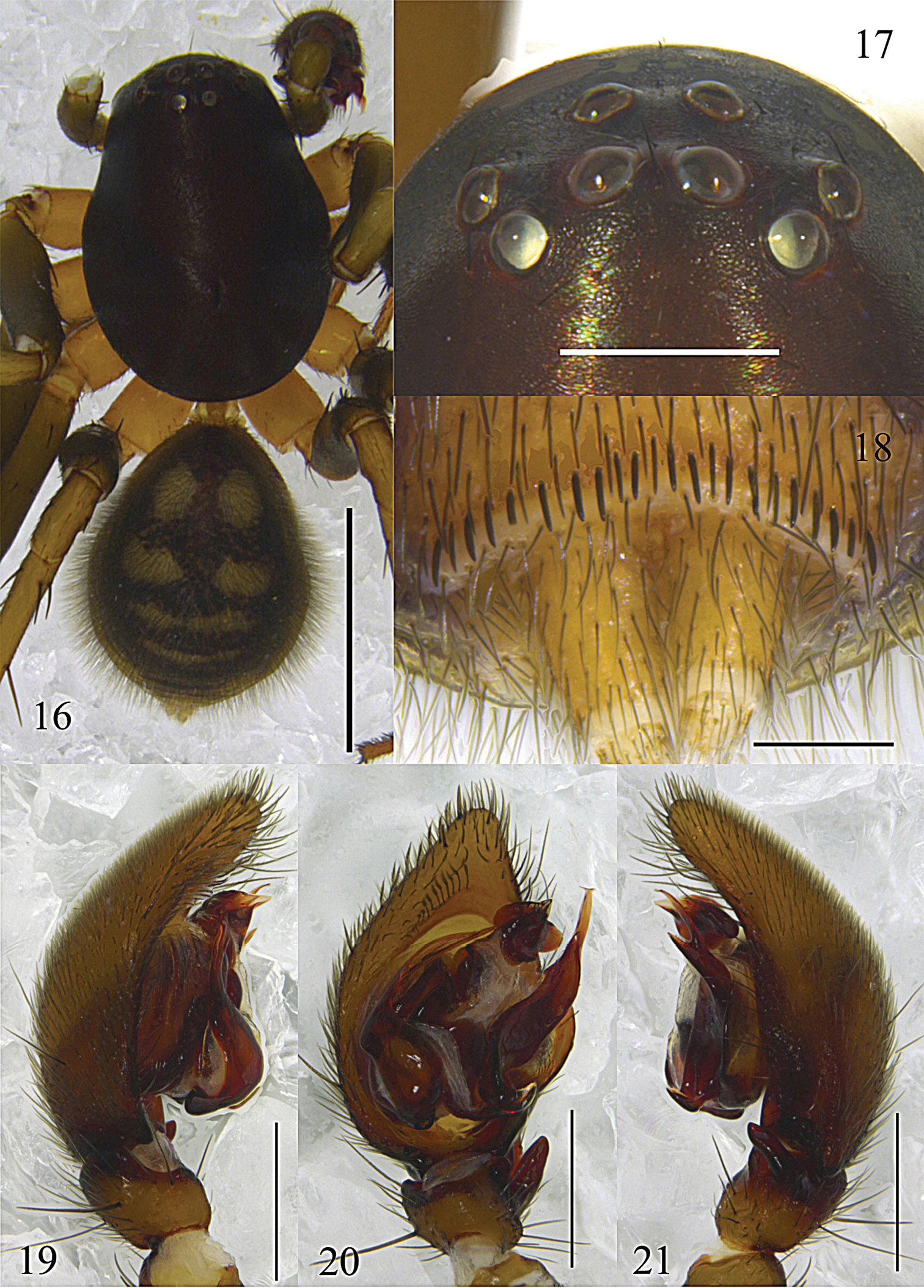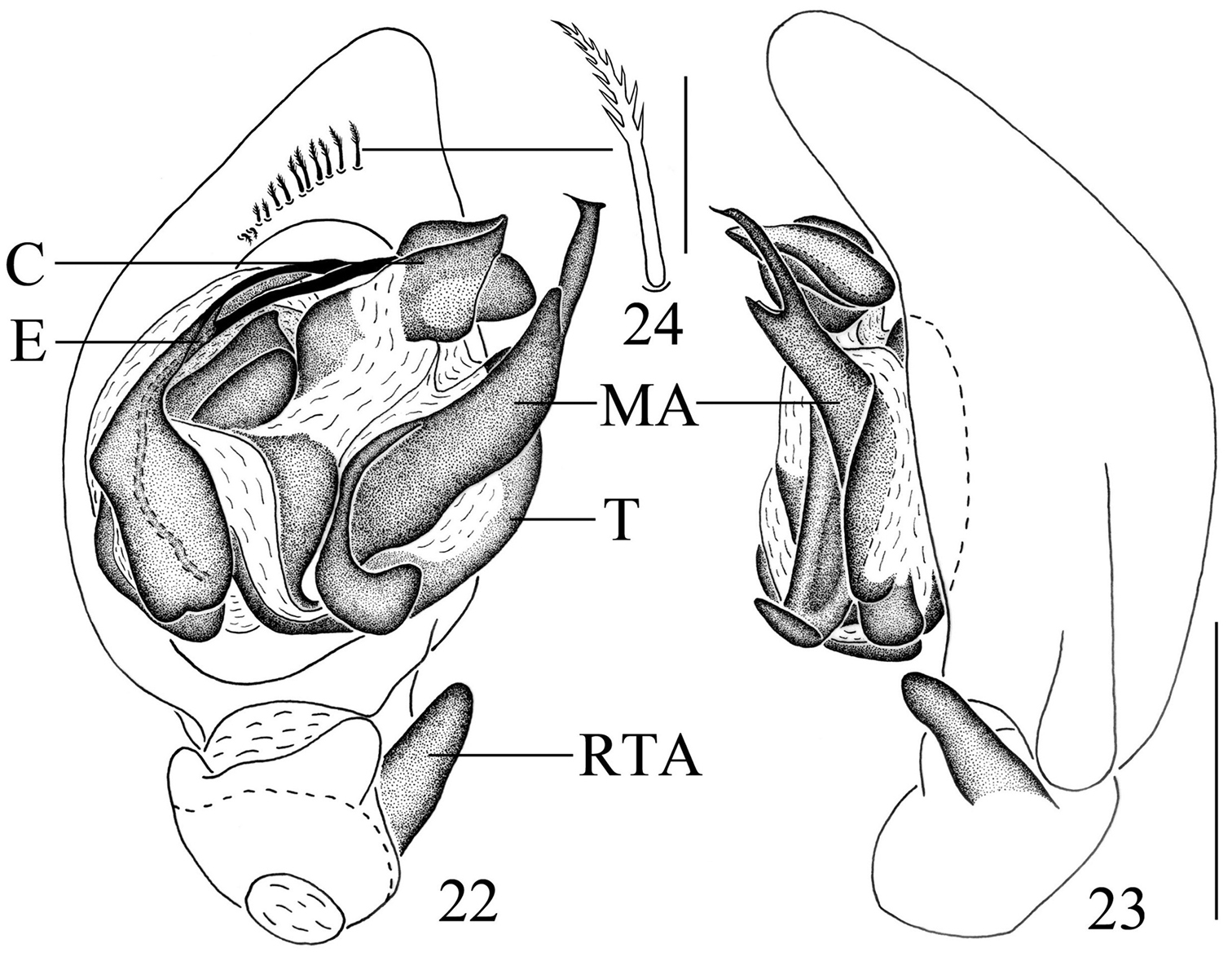






(C) 2013 Chi Jin. This is an open access article distributed under the terms of the Creative Commons Attribution License 3.0 (CC-BY), which permits unrestricted use, distribution, and reproduction in any medium, provided the original author and source are credited.
For reference, use of the paginated PDF or printed version of this article is recommended.
Two new species of the spider genus Mallinella Strand, 1906 are reported from China: Mallinella sphaerica sp. n. (male, female) from Tianmu Mountain, Zhejiang Province and Mallinella pluma sp. n. (male) from Daming Mountain, Guangxi Zhuang Autonomous Region.
Spider, Mallinella, taxonomy, new species, China
The spider family Zodariidae is represented by 78 genera and 1068 known species mainly from Africa, Australia and Asia (
The genus Mallinella was established by Strand in 1906, was redefined by
While examining spiders collected from Tianmu Mountain, Zhejiang Province, and Daming Mountain, Guangxi Zhuang Autonomous Region of southern China, we found two species new to science – Mallinella sphaerica sp. n. and Mallinella pluma sp. n. that are described herein.
All specimens were kept in 75% ethanol, examined and measured under a Tech XTL-II stereomicroscope. Drawings of Mallinella sphaerica sp. n. were prepared under a Nikon SMZ 1500 stereomicroscope equipped with a drawing tube, and Mallinella pluma sp. n. under a Leica M165C stereomicroscope equipped with a drawing tube. The photos were taken with a Leica M205A stereomicroscope equipped with a DFC450 CCD. Carapace length was measured from the anterior margin to the centre of the posterior margin. Eye size was measured as the maximum diameter of the lens in dorsal or frontal view. The leg measurements are presented as total length (femur, patella, tibia, metatarsus, tarsus). The epigyne was cleaned in a warm solution of potassium hydroxide (KOH) and transferred to 75% ethanol for drawing. All measurements are in millimeter. All specimens studied are deposited in the Museum of Hebei University (MHBU), Baoding, China.
ALE anterior lateral eyes
AME anterior median eyes
C conductor
CD copulatory ducts
E embolus
EP epigynal plate
MA median apophysis
MOA median ocular area
PLE posterior lateral eyes
PME posterior median eyes
RTA retrolateral tibial apophysis
S spermathecae
T tegulum.
urn:lsid:zoobank.org:act:6591D5D0-F5D3-4498-8C74-3900F1A8270C
http://species-id.net/wiki/Mallinella_sphaerica
Figs 1–15Holotype ♂, CHINA, Zhejiang Province: Tianmu Mountain (30°18'N, 119°27'E), alt. 262m, Lin’an City, 25 July 2011, C. Jin leg. Paratype: 1♀, same data as holotype.
According to
The specific name is a Latin adjective and refers to the spherical median part of the median apophysis.
Male (holotype). Total length 6.27; prosoma 3.11 long, 2.14 wide; opisthosoma 2.96 long, 1.99 wide. Diameters of eyes: AME 0.20, ALE 0.15, PME 0.15, PLE 0.15. Distances between eyes: AME–AME 0.08, AME–ALE 0.10, ALE–ALE 0.55, PME–PME 0.13, PME–PLE 0.25, PLE–PLE 0.78, ALE–PLE 0.05. MOA 0.48 long, anterior 0.50, posterior 0.43. Clypeal height 0.75. Labium 0.58 long, 0.50 wide. Sternum 1.35 long, 1.28 wide. Leg measurements: leg I 10.36 (2.55, 0.77, 2.35, 2.65, 2.04), II 9.90 (2.50, 0.92, 2.04, 2.60, 1.84), III 9.29 (2.35, 0.82, 1.94, 2.65, 1.53), IV 12.09 (2.70, 0.92, 2.60, 3.88, 1.99). Leg formula: 4123.
Carapace (Fig. 1) blackish-brown; fovea black, slightly swollen. Both eye rows (Fig. 3) procurved in dorsal view. Clypeus dark brown. Chelicerae dark brown, distally yellowish-brown. Endites yellowish-brown. Labium triangular, dark brown, distally yellowish-brown. Sternum brown and furnished with sparse black setae, lateral margin with small, pointed extensions fitting in coxal concavities. Legs brown, femora dark brown, coxae yellowish-brown; metatarsi II–IV distally with ventral hair tufts. Opisthosoma (Fig. 1) oval, longer than wide, dorsum with three pairs of white lateral patches (the third connected), followed by one transverse white patch centrally. Dorsal scutum reddish-brown, about half as long as opisthosoma. Venter grey-black, covered with three irregular longitudinal white stripes; posterior ventral spines thin (Fig. 5), arranged in a single row. Spinnerets pale yellow.
Palpal organ (Figs 9–11, 14, 15). RTA digitiform, slightly wider at base, gradually tapering towards pointed apex. Cymbial fold broad, approximately half as long as cymbium. Apex of median apophysis bifid, with sharply pointed tips on both ends; the median part of median apophysis spherical; baso-retrolateral fold narrow, triangular, apex pointed. Apex of conductor irregularly rolled. Embolus bifurcate, lateral ramus shorter than mesal ramus, with pointed apices.
Female (paratype). Total length 8.26; prosoma 3.57 long, 2.55 wide; opisthosoma 4.28 long, 2.75 wide. Diameters of eyes: AME 0.20, ALE 0.18, PME 0.18, PLE 0.18. Distances between eyes: AME–AME 0.08, AME–ALE 0.10, ALE–ALE 0.60, PME–PME 0.15, PME–PLE 0.28, PLE–PLE 0.88, ALE–PLE 0.05. MOA 0.53 long, anterior width 0.45, posterior width 0.50. Clypeal height 1.03, Labium 0.63 long, 0.63 wide. Sternum 1.53 long, 1.53 wide. Leg measurements: leg I 8.68 (2.45, 0.97, 1.94, 1.79, 1.53), II 8.47 (2.19, 0.97, 1.79, 1.99, 1.53), III 8.00 (2.19, 0.92, 1.68, 2.14, 1.07), IV 10.34 (2.14, 1.02, 2.24, 3.06, 1.68). Leg formula: 4123.
Coloration and pattern (Fig. 2) as in male, but the color of coxae slightly paler than in male. Median furrow and scutum indistinct.
Epigyne-vulva (Figs 7, 8, 12, 13). Epigynal plate small, nearly reniform, with swollen posterior margin; copulatory openings hidden in a groove. Spermathecae large and oval; copulatory ducts thin; slender fertilization ducts invisible in dorsal view.
Mallinella sphaerica sp. n., 1 male habitus, dorsal view 2 female habitus, dorsal view 3 male ocular area, frontal view 4 female, ocular area, frontal view 5 male, posterior ventral spines, ventral view 6 female, posterior ventral spines, ventral view. Scale bars: 2 mm (1–2); 0.5 mm (3–4); 0.2 mm (5–6).
Mallinella sphaerica sp. n., 7 epigyne, ventral view 8 vulva 9 left male palp, prolateral view 10 same, ventral view 11 same, retrolateral view. Scale bars: 0.5 mm (7–11).
Mallinella sphaerica sp. n., 12 epigyne, ventral view 13 vulva 14 left male palp, ventral view 15 same, retrolateral view. Scale bars: 0.2 mm (12–13); 0.5 mm (14–15).
China (Zhejiang).
urn:lsid:zoobank.org:act:0E7F143C-78AA-4CF0-A24D-9F1926101EB8
http://species-id.net/wiki/Mallinella_pluma
Figs 16–24Holotype♂, CHINA, Guangxi, Zhuang Autonomous Region: Daming Mountain (23°31'N, 108°21'E; 398m), Wuming County, Nanning City, 20 May 2011, Y. N. Wang leg.
Male can be easily distinguished from other Mallinella males by the extremely narrow and long median apophysis (almost 2/3 cymbium length in ventral view), by the ventral row of plumose hairs near the tip of the cymbium (Figs 20, 22, 24), and also by the dense dorsal hair cover of the opisthosoma (Fig. 16).
The specific name is a Latin noun and refers to the plumose hairs near the tip of cymbium.
Male (holotype). Total length 5.30; prosoma 2.86 long, 2.04 wide; opisthosoma 2.24 long, 1.84 wide. Diameters of eyes: AME 0.18, ALE 0.15, PME 0.13, PLE 0.15. Distances between eyes: AME–AME 0.08, AME–ALE 0.10, ALE–ALE 0.50, PME–PME 0.13, PME–PLE 0.23, PLE–PLE 0.73, ALE–PLE 0.05. MOA 0.40 long, front width 0.40, back width 0.38. Clypeal height 0.80. Labium 0.53 long, 0.48 wide. Sternum 1.28 long, 1.22 wide. Measurements of legs: leg I 9.51 (2.30, 0.77, 2.24, 2.35, 1.85), II 8.83 (2.19, 0.82, 1.89, 2.35, 1.58), III 8.57 (2.09, 0.77, 1.73, 2.55, 1.43), IV 11.22 (2.65, 0.82, 2.55, 3.62, 1.58). Leg formula: 4123.
Carapace (Fig. 16) dark brown; median furrow black. Both eye rows (Fig. 17) procurved in dorsal view. Clypeus brown. Chelicerae brown, distally yellowish-brown. Endites yellowish. Labium triangular and brown, distally white. Sternum yellowish-brown and furnished with sparse black setae, lateral margin with small and pointed extensions fitting in coxal concavities of legs. Legs light yellowish-brown except femora that are light brown; metatarsi II–IV distally with ventral hair tufts. Opisthosoma (Fig. 16) oval, longer than wide, dorsally black, with dense hairs and three pairs of white lateral patches (the third slight connected), followed by one transverse white median patch; dorsal scutum indistinct; venter grey-black, covered with three irregular longitudinal white stripes; posterior ventral spines thin (Fig. 18), arranged in a single row. Spinnerets pale yellow.
Palpal organ (Figs 19–24). RTA digitiform, slightly wider at base, gradually tapering towards its blunt apex. Cymbium ventrally with a row of plumose hairs near its tip; cymbial fold broad, more than half as long as cymbium. Apex of median apophysis rostrated and pointing to the prolateral side; the median part of median apophysis with a small digitiform branch; baso-retrolateral fold narrow and long, spatulate, apex blunt. Conductor complex, with a triangular apophysis retrolaterally. Embolus bifurcated at the median part, lateral ramus shorter than mesal ramus, only lateral ramus with subterminal fold.
Female unknown.
Mallinella pluma sp. n., 16 male habitus, dorsal view 17 ocular area, frontal view 18 male, posterior ventral spines, ventral view 19 left male palp, prolateral view 20 same, ventral view 21 same, retrolateral view. Scale bars: 2 mm (16); 0.2 mm (17); 0.5 mm (18–21).
Mallinella pluma sp. n., 22 left male palp, ventral view 23 same, retrolateral view 24 a plumose hair (magnified). Scale bars: 0.5 mm (22–23); 0.05 mm (24).
According to
China (Guangxi).
We are grateful to Yingnan Wang for collecting the specimen from Guangxi. We are grateful to two anonymous referees for their valuable comments. This study was supported by the National Natural Science Foundation of China (No. 31071885, 30970325, 31093430), partly by the Education Office of Hebei Province, China (No. Z2009101) and the Natural Science Foundation of Baoding University (No. 2010Z01).
